Dosing & Uses
Dosage Forms & Strengths
lyophilized powder for reconstitution
- 150mg
injectable solution
- 10mg/mL (in vials of 50, 150, 450, and 600 mg)
Advanced Ovarian Carcinoma
Single agent: 360 mg/m² IV q4Weeks
Combination treatment: 300 mg/m² IV (plus cyclophosphamide 600 mg/m² IV) q4Weeks
Dose Modifications
For SI units: Count in US units x 10^6/L
Give full dose if
- Platelets 50-100,000
- Neutrophils 500-2000
Give 125% if
- Platelets >100000
- Neutrophils >2000
Give 75% if
- Platelets <50000
- Neutrophils <500
Renal Impairment
CrCl 41-59 mL/min: 250 mg/m² IV on day 1
CrCl 16-40 mL/min: 200 mg/m² IV on day 1
CrCl <15 mL/min: Not recommended
Hepatic Impairment
Dose adjustment may not be necessary; not studied
Administration
Do not repeat dose until ANC >2000 AND platelets >100000
Infuse over >15 minutes
Monitor: CBC weekly
Other Indications & Uses
Off-label: testicular cancer, head and neck cancer, cervix cancer, small cell lung cancer, progressive diffuse large B-cell lymphoma
Dosage Forms & Strengths
lyophilized powder for reconstitution
- 150mg
injectable solution
- 10mg/mL (in vials of 50, 150, 450, and 600 mg)
General Dosing Guidelines
Solid tumor
Sarcoma (bone/soft tissue)
- 400 mg/m²/day for 2 days every 21 days
Brain tumor
- 175 mg/m² qWeek x 4 weeks with a 2 weeks recovery period between courses
Bone marrow transplant preparative regimen
- 500 mg/m²/day x 3 days
Retinoblastoma
- 1-2 mL subconjunctival injection of 10 mg/mL solution per dose
Calvert formula should be used to calculate dosing
Interactions
Interaction Checker
No Results

Contraindicated
Serious - Use Alternative
Significant - Monitor Closely
Minor

Contraindicated (0)
Serious - Use Alternative (16)
- adenovirus types 4 and 7 live, oral
carboplatin decreases effects of adenovirus types 4 and 7 live, oral by pharmacodynamic antagonism. Avoid or Use Alternate Drug. Immunosuppressives may diminish therapeutic effects of vaccines and increase risk of adverse effects (increased risk of infection). Live-attenuated vaccines should be avoided for at least 3mo after cessation of immunosuppressive therapy.
- amphotericin B deoxycholate
amphotericin B deoxycholate and carboplatin both increase nephrotoxicity and/or ototoxicity. Avoid or Use Alternate Drug.
- axicabtagene ciloleucel
carboplatin, axicabtagene ciloleucel. Either increases effects of the other by immunosuppressive effects; risk of infection. Avoid or Use Alternate Drug.
- bacitracin
carboplatin and bacitracin both increase nephrotoxicity and/or ototoxicity. Avoid or Use Alternate Drug. Avoid concurrent use of bacitracin with other nephrotoxic drugs
- brexucabtagene autoleucel
carboplatin, brexucabtagene autoleucel. Either increases effects of the other by immunosuppressive effects; risk of infection. Avoid or Use Alternate Drug.
- cidofovir
carboplatin and cidofovir both increase nephrotoxicity and/or ototoxicity. Avoid or Use Alternate Drug. Concomitant use of cidofovir and agents with nephrotoxic potential is contraindicated. Such agents must be discontinued at least 7 days prior to starting therapy with cidofovir.
- ciltacabtagene autoleucel
carboplatin, ciltacabtagene autoleucel. Either increases effects of the other by immunosuppressive effects; risk of infection. Avoid or Use Alternate Drug.
- etrasimod
etrasimod, carboplatin. Either increases effects of the other by immunosuppressive effects; risk of infection. Avoid or Use Alternate Drug. Risk of additive immune system effects with etrasimod has not been studied in combination with antineoplastic, immune-modulating, or noncorticosteroid immunosuppressive therapies. Avoid coadministration during and in the weeks following administration of etrasimod.
- idecabtagene vicleucel
carboplatin, idecabtagene vicleucel. Either increases effects of the other by immunosuppressive effects; risk of infection. Avoid or Use Alternate Drug.
- influenza virus vaccine quadrivalent, adjuvanted
carboplatin decreases effects of influenza virus vaccine quadrivalent, adjuvanted by pharmacodynamic antagonism. Avoid or Use Alternate Drug. Immunosuppressive drugs may reduce the immune response to influenza vaccine.
- influenza virus vaccine trivalent, adjuvanted
carboplatin decreases effects of influenza virus vaccine trivalent, adjuvanted by pharmacodynamic antagonism. Avoid or Use Alternate Drug. Immunosuppressive drugs may reduce the immune response to influenza vaccine.
- lisocabtagene maraleucel
carboplatin, lisocabtagene maraleucel. Either increases effects of the other by immunosuppressive effects; risk of infection. Avoid or Use Alternate Drug.
- palifermin
palifermin increases toxicity of carboplatin by Other (see comment). Avoid or Use Alternate Drug. Comment: Palifermin should not be administered within 24 hrbefore, during infusion of, or within 24 hr after administration of antineoplastic agents. Coadministration of palifermin within 24 hr of chemotherapy resulted in increased severity and duration of oral mucositis.
- ropeginterferon alfa 2b
ropeginterferon alfa 2b, carboplatin. Either increases toxicity of the other by Other (see comment). Avoid or Use Alternate Drug. Comment: Myelosuppressive agents can produce additive myelosuppression. Avoid use and monitor patients receiving the combination for effects of excessive myelosuppression.
- tisagenlecleucel
carboplatin, tisagenlecleucel. Either increases effects of the other by immunosuppressive effects; risk of infection. Avoid or Use Alternate Drug.
- tofacitinib
carboplatin, tofacitinib. Either increases toxicity of the other by immunosuppressive effects; risk of infection. Avoid or Use Alternate Drug.
Monitor Closely (58)
- acalabrutinib
acalabrutinib, carboplatin. Either increases toxicity of the other by pharmacodynamic synergism. Use Caution/Monitor. Coadministration may increase risk of myelosuppressive effects.
- acyclovir
acyclovir and carboplatin both increase nephrotoxicity and/or ototoxicity. Use Caution/Monitor.
- adefovir
adefovir and carboplatin both increase nephrotoxicity and/or ototoxicity. Use Caution/Monitor.
- amikacin
amikacin and carboplatin both increase nephrotoxicity and/or ototoxicity. Use Caution/Monitor.
- belatacept
belatacept and carboplatin both increase immunosuppressive effects; risk of infection. Use Caution/Monitor.
- bendamustine
bendamustine, carboplatin. Either increases toxicity of the other by pharmacodynamic synergism. Use Caution/Monitor. Additive myelosuppression.
- busulfan
busulfan, carboplatin. Either increases toxicity of the other by pharmacodynamic synergism. Use Caution/Monitor. Additive myelosuppression.
- capreomycin
capreomycin and carboplatin both increase nephrotoxicity and/or ototoxicity. Use Caution/Monitor.
- carmustine
carboplatin, carmustine. Either increases toxicity of the other by pharmacodynamic synergism. Use Caution/Monitor. Additive myelosuppression.
- chlorambucil
carboplatin, chlorambucil. Either increases toxicity of the other by pharmacodynamic synergism. Use Caution/Monitor. Additive myelosuppression.
- cholera vaccine
carboplatin decreases effects of cholera vaccine by immunosuppressive effects; risk of infection. Modify Therapy/Monitor Closely. Immunosuppressive therapies, including irradiation, antimetabolites, alkylating agents, cytotoxic drugs and corticosteroids (used in greater than physiologic doses), may reduce the immune response to cholera vaccine.
- cisplatin
carboplatin and cisplatin both increase nephrotoxicity and/or ototoxicity. Use Caution/Monitor.
carboplatin, cisplatin. Either increases toxicity of the other by pharmacodynamic synergism. Use Caution/Monitor. Additive myelosuppression. - colistin
carboplatin and colistin both increase nephrotoxicity and/or ototoxicity. Use Caution/Monitor.
- cyclophosphamide
carboplatin, cyclophosphamide. Either increases toxicity of the other by pharmacodynamic synergism. Use Caution/Monitor. Additive myelosuppression.
- cyclosporine
carboplatin and cyclosporine both increase nephrotoxicity and/or ototoxicity. Use Caution/Monitor.
- dacarbazine
carboplatin, dacarbazine. Either increases toxicity of the other by pharmacodynamic synergism. Use Caution/Monitor. Additive myelosuppression.
- dengue vaccine
carboplatin decreases effects of dengue vaccine by immunosuppressive effects; risk of infection. Use Caution/Monitor. Immunosuppressive therapies (eg, irradiation, antimetabolites, alkylating agents, cytotoxic drugs, corticosteroids [greater than physiologic doses]) may reduce immune response to dengue vaccine.
- denosumab
carboplatin, denosumab. Other (see comment). Use Caution/Monitor. Comment: Caution should be taken in patients on concomitant immunosuppressants or with impaired immune systems because of increased risk for serious infections.
- dichlorphenamide
dichlorphenamide and carboplatin both decrease serum potassium. Use Caution/Monitor.
- elvitegravir/cobicistat/emtricitabine/tenofovir DF
carboplatin and elvitegravir/cobicistat/emtricitabine/tenofovir DF both increase nephrotoxicity and/or ototoxicity. Use Caution/Monitor.
- ethotoin
carboplatin decreases levels of ethotoin by unknown mechanism. Use Caution/Monitor.
- fingolimod
carboplatin increases effects of fingolimod by immunosuppressive effects; risk of infection. Modify Therapy/Monitor Closely. Concomitant therapy is expected to increase the risk of immunosuppression. Use caution when switching patients from long-acting therapies with immune effects. .
- foscarnet
carboplatin and foscarnet both increase nephrotoxicity and/or ototoxicity. Use Caution/Monitor.
- fosphenytoin
carboplatin decreases levels of fosphenytoin by unknown mechanism. Use Caution/Monitor.
- gentamicin
carboplatin and gentamicin both increase nephrotoxicity and/or ototoxicity. Use Caution/Monitor.
- hydroxyurea
carboplatin, hydroxyurea. Other (see comment). Use Caution/Monitor. Comment: Combination may increase risk of myelosuppression.
- ifosfamide
carboplatin, ifosfamide. Either increases toxicity of the other by pharmacodynamic synergism. Use Caution/Monitor. Additive myelosuppression.
- influenza A (H5N1) vaccine
carboplatin decreases effects of influenza A (H5N1) vaccine by pharmacodynamic antagonism. Use Caution/Monitor. Immunosuppressive therapies may reduce immune response to H5N1 vaccine.
- influenza virus vaccine (H5N1), adjuvanted
carboplatin decreases effects of influenza virus vaccine (H5N1), adjuvanted by pharmacodynamic antagonism. Use Caution/Monitor. Immunosuppressive therapies may reduce immune response to H5N1 vaccine.
- ioversol
carboplatin and ioversol both increase nephrotoxicity and/or ototoxicity. Modify Therapy/Monitor Closely.
- isavuconazonium sulfate
carboplatin and isavuconazonium sulfate both decrease immunosuppressive effects; risk of infection. Use Caution/Monitor.
- lomustine
carboplatin, lomustine. Either increases toxicity of the other by pharmacodynamic synergism. Use Caution/Monitor. Additive myelosuppression.
- meningococcal group B vaccine
carboplatin decreases effects of meningococcal group B vaccine by pharmacodynamic antagonism. Use Caution/Monitor. Individuals with altered immunocompetence may have reduced immune responses to the vaccine.
- methotrexate
carboplatin and methotrexate both increase nephrotoxicity and/or ototoxicity. Use Caution/Monitor.
- neomycin PO
carboplatin and neomycin PO both increase nephrotoxicity and/or ototoxicity. Use Caution/Monitor.
- ofatumumab SC
ofatumumab SC, carboplatin. Either increases effects of the other by immunosuppressive effects; risk of infection. Use Caution/Monitor. Consider the risk of additive immune system effects when coadministering immunosuppressive therapies with coadministration. When switching from therapies with immune effects, take into account the duration and mechanism of action of these therapies when initiating ofatumumab SC.
- olaparib
carboplatin and olaparib both increase pharmacodynamic synergism. Use Caution/Monitor. Coadministration with other other myelosuppressive anticancer agents, including DNA damaging agents, may potentiate and prolongate the myelosuppressive toxicity.
- oxaliplatin
carboplatin and oxaliplatin both increase nephrotoxicity and/or ototoxicity. Use Caution/Monitor.
- paromomycin
carboplatin and paromomycin both increase nephrotoxicity and/or ototoxicity. Use Caution/Monitor.
- pentamidine
carboplatin and pentamidine both increase nephrotoxicity and/or ototoxicity. Use Caution/Monitor.
- peramivir
carboplatin increases levels of peramivir by decreasing renal clearance. Use Caution/Monitor. Caution when peramivir coadministered with nephrotoxic drugs.
- phenytoin
carboplatin decreases levels of phenytoin by unknown mechanism. Use Caution/Monitor.
- polymyxin B
carboplatin and polymyxin B both increase nephrotoxicity and/or ototoxicity. Use Caution/Monitor.
- siponimod
siponimod and carboplatin both increase immunosuppressive effects; risk of infection. Use Caution/Monitor. Caution if coadministered because of additive immunosuppressive effects during such therapy and in the weeks following administration. When switching from drugs with prolonged immune effects, consider the half-life and mode of action of these drugs to avoid unintended additive immunosuppressive effects.
- sipuleucel-T
carboplatin decreases effects of sipuleucel-T by pharmacodynamic antagonism. Modify Therapy/Monitor Closely.
- sodium sulfate/?magnesium sulfate/potassium chloride
sodium sulfate/?magnesium sulfate/potassium chloride increases toxicity of carboplatin by Other (see comment). Use Caution/Monitor. Comment: Coadministration with medications that cause fluid and electrolyte abnormalities may increase the risk of adverse events of seizure, arrhythmias, and renal impairment.
- sodium sulfate/potassium sulfate/magnesium sulfate
sodium sulfate/potassium sulfate/magnesium sulfate increases toxicity of carboplatin by Other (see comment). Use Caution/Monitor. Comment: Coadministration with medications that cause fluid and electrolyte abnormalities may increase the risk of adverse events of seizure, arrhythmias, and renal impairment.
- streptomycin
carboplatin and streptomycin both increase nephrotoxicity and/or ototoxicity. Use Caution/Monitor.
- streptozocin
carboplatin and streptozocin both increase nephrotoxicity and/or ototoxicity. Use Caution/Monitor.
carboplatin, streptozocin. Either increases toxicity of the other by pharmacodynamic synergism. Use Caution/Monitor. Additive myelosuppression. - tacrolimus
carboplatin and tacrolimus both increase nephrotoxicity and/or ototoxicity. Use Caution/Monitor.
- tenofovir DF
carboplatin and tenofovir DF both increase nephrotoxicity and/or ototoxicity. Use Caution/Monitor. Combination may also increase tenofovir levels.
- tobramycin
carboplatin and tobramycin both increase nephrotoxicity and/or ototoxicity. Use Caution/Monitor.
- tobramycin inhaled
tobramycin inhaled and carboplatin both increase nephrotoxicity and/or ototoxicity. Modify Therapy/Monitor Closely. Avoid concurrent or sequential use to decrease risk for ototoxicity
- trastuzumab
trastuzumab, carboplatin. Either increases toxicity of the other by immunosuppressive effects; risk of infection. Use Caution/Monitor. Neutropenia or febrile neutropenia incidence were increased when trastuzumab was coadministered with myelosuppressive chemotherapy. .
- trastuzumab deruxtecan
trastuzumab deruxtecan, carboplatin. Either increases toxicity of the other by immunosuppressive effects; risk of infection. Use Caution/Monitor. Neutropenia or febrile neutropenia incidence were increased when trastuzumab was coadministered with myelosuppressive chemotherapy. .
- vancomycin
carboplatin and vancomycin both increase nephrotoxicity and/or ototoxicity. Use Caution/Monitor.
- voclosporin
voclosporin, carboplatin. Either increases toxicity of the other by nephrotoxicity and/or ototoxicity. Modify Therapy/Monitor Closely. Coadministration with drugs associated with nephrotoxicity may increase the risk for acute and/or chronic nephrotoxicity.
- zidovudine
carboplatin, zidovudine. Either increases toxicity of the other by pharmacodynamic synergism. Use Caution/Monitor. Increased risk of myelosuppression.
Minor (2)
- vitamin A
vitamin A, carboplatin. Mechanism: pharmacodynamic synergism. Minor/Significance Unknown. Antioxidants such as vitamin A enhance the efficacy, and reduce toxicity, of antineoplastic drugs.
- vitamin E
vitamin E, carboplatin. Mechanism: pharmacodynamic synergism. Minor/Significance Unknown. Antioxidants such as vitamin E enhance the efficacy, and reduce toxicity, of antineoplastic drugs.
Adverse Effects
>10%
Leukopenia (26-97%)
Neutropenia (21-96%)
Nausea (81-93%)
Vomiting (81-93%)
Anemia (14-90%)
Magnesium loss (43-61%)
Thrombocytopenia (33-66%)
Alopecia (2-49%)
Asthenia (11-41%)
Elevated alkaline phosphatase (29-37%)
Central neurotoxicity (5-26%)
Elevated AST (19-20%)
Peripheral neuropathy (6-15%)
1-10%
Immune hypersensitivity reaction (2-9.2%)
Elevated bilirubin (5%)
Frequency Not Defined
Visual disturbance (rare)
Postmarketing Reports
Dehydration
Stomatitis
Warnings
Black Box Warnings
The drug should be administered under the supervision of an experienced cancer chemotherapy physician. Increased risk of allergic reactions in patients previously exposed to platinum. The allergic reaction may occur within minutes of carboplatin administration
Bone marrow suppression, which may be severe and may result in infection or bleeding, is dose related. Reduce dosage in patients with bone marrow suppression and impaired renal function. Anemia is cumulative
Vomiting is a frequent adverse effect and is dose related
Contraindications
Severe hypersensitivity to carboplatin, other platinum compounds, mannitol
Severe myelosuppression, significant bleeding
Severe renal dysfunction
Pregnancy/lactation
Cautions
Pediatric patients, elderly, renal impairment, hearing impairment, neuropathy, neuromuscular disease, prior cisplatin treatment, concomitant neurotoxic agents, concomitant ototoxic agents
Less nephrotoxic than cisplatin
Avoid pregnancy
Ototoxicity may occur
Caution in patients with renal impairment; patients with renal failure are at increased risk for bone marrow suppression
Carboplatin has limited nephrotoxic potential, but concomitant treatment with aminoglycosides has resulted in increased renal and/or audiologic toxicity, and caution must be exercised when a patient receives both drugs; clinically significant hearing loss has been reported to occur in pediatric patients when carboplatin was administered at higher than recommended doses in combination with other ototoxic agents
Therapy can induce emesis, which can be more severe in patients previously receiving emetogenic therapy; the incidence and intensity of emesis have been reduced by using premedication with antiemetics; although no conclusive efficacy data exist, lengthening the duration of single intravenous administration to 24 hours or dividing the total dose over 5 consecutive daily pulse doses has resulted in reduced emesis
Although peripheral neurotoxicity is infrequent, its incidence is increased in patients older than 65 years and in patients previously treated with cisplatin; pre-existing cisplatin-induced neurotoxicity does not worsen in about 70% of the patients receiving carboplatin as secondary treatment
Loss of vision, which can be complete for light and colors, has been reported after use of carboplatin with doses higher than those recommended in the package insert; vision appears to recover totally or to a significant extent within weeks of stopping these high doses
As in the case of other platinum-coordination compounds, allergic reactions to carboplatin have been reported; these may occur within minutes of administration and should be managed with appropriate supportive therapy; there is increased risk of allergic reactions including anaphylaxis in patients previously exposed to platinum therapy
High dosages of carboplatin (more than 4 times the recommended dose) have resulted in severe abnormalities of liver function tests
Needles or intravenous administration sets containing aluminum parts that may come in contact with carboplatin Injection should not be used for preparation or administration of the drug; aluminum can react with carboplatin causing precipitate formation and loss of potency
Bone marrow suppression
- Bone marrow suppression (leukopenia, neutropenia, and thrombocytopenia) is dose-dependent and is also the dose-limiting toxicity; peripheral blood counts should be frequently monitored during treatment and, when appropriate, until recovery achieved
- Median nadir occurs at day 21 in patients receiving single-agent carboplatin; in general, single intermittent courses should not be repeated until leukocyte, neutrophil, and platelet counts have recovered
- Since anemia is cumulative, transfusions may be needed during treatment, particularly in patients receiving prolonged therapy; bone marrow suppression is increased in patients who have received prior therapy, especially regimens including cisplatin
- Marrow suppression is increased in patients with impaired kidney function; initial dosages in these patients should be appropriately reduced and blood counts should be carefully monitored between courses; the use in combination with other bone marrow suppressing therapies must be carefully managed with respect to dosage and timing in order to minimize additive effects
Pregnancy & Lactation
Pregnancy
Injection may cause fetal harm when administered to a pregnant woman; the drug has been shown to be embryotoxic and teratogenic in rats; there are no adequate and well-controlled studies in pregnant women; if this drug is used during pregnancy, or if patient becomes pregnant while in therapy, the patient should be apprised of potential hazard to fetus; women of childbearing potential should be advised to avoid becoming pregnant
Lactation
Not known whether carboplatin is excreted in human milk; because there is possibility of toxicity in nursing infants secondary to treatment of the mother, it is recommended that breast-feeding be discontinued if the mother is treated
Pregnancy Categories
A: Generally acceptable. Controlled studies in pregnant women show no evidence of fetal risk.
B: May be acceptable. Either animal studies show no risk but human studies not available or animal studies showed minor risks and human studies done and showed no risk. C: Use with caution if benefits outweigh risks. Animal studies show risk and human studies not available or neither animal nor human studies done. D: Use in LIFE-THREATENING emergencies when no safer drug available. Positive evidence of human fetal risk. X: Do not use in pregnancy. Risks involved outweigh potential benefits. Safer alternatives exist. NA: Information not available.Pharmacology
Mechanism of Action
Platinum coordination compound; covalently binds to DNA; cross-links strands of DNA
Not a true alkylating agent
Absorption
Peak plasma time: 2-4 hr
Distribution
Protein bound: 87% (platinum)
Vd: 16 L
Elimination
Clearance: 4.4 L/hr
Excretion: Urine (70% as carboplatin)
Half-life
- Carboplatin: 3-6 hr
- Free ultrafilterable platinum: 6 hr
- Total plasma platinum: 4-6 days
Administration
IV Incompatibilities
Solution: Na Bicarb 200 mM
Additive: fluorouracil, mesna
Y-site: amphotericin B cholesteryl-SO4
IV Compatibilities
Solution: D5W, D5W in NS, NS
Additive: cisplatin, etoposide, floxuridine, ifosfamide, ifosfamide with etoposide, paclitaxel
Y-site (partial list): allopurinol, etoposide PO4, filgrastim, gemcitabine, granisetron, linezolid, ondansetron, paclitaxel, piperacillin-tazobactam, propofol
IV Preparation
Single-dose lyophilized powder (reconstitution require)
- Reconstitute powder with sterile water for injection, D5W, or 0.9% NaCl to yield a final concentration of 10 mg/mL
- Can be further diluted to concentrations as low as 0.5 mg/mL with D5W or 0.9% NaCl
Multidose premixed injectable solution
- Available as a 10 mg/mL aqueous solution
- Can be further diluted to concentrations as low as 0.5 mg/mL with D5W or 0.9% NaCl
IV Administration
Administer IV over 15 min or continuous IV infusion over 24 hr
May also be administered intraperitoneally
When administered as sequential infusions, taxane derivatives (docetaxel, paclitaxel) should be administered before platinum derivatives to limit myelosuppression and to enhance efficacy
Do not use aluminum-containing needles or IV administration sets that may come in contact with carboplatin (aluminum can cause precipitate formation and loss of potency)
Storage
Single-dose lyophilized powder (reconstitution required)
- Unreconstituted vials: Stable at controlled room temperature (20-25°C [68-77°F]); protect from light
- Reconstituted vials and diluted solutions: Stable for 8 hr at room temperature (25°C [77°C]); since no antibacterial preservative is contained in the formulation, discard 8 hr after dilution
Multidose premixed injectable solution
- Unopened multidose vials: Stable to the date indicated on the package when stored at 20-25°C (68-77°F) and protected from light
- Multidose vials maintain microbial, chemical, and physical stability for up to 14 days at 25°C following multiple needle entries
Images
| BRAND | FORM. | UNIT PRICE | PILL IMAGE |
|---|---|---|---|
| carboplatin intravenous - | 10 mg/mL vial | 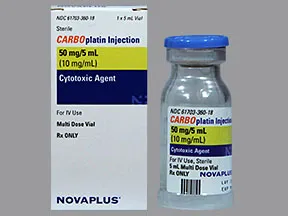 | |
| carboplatin intravenous - | 10 mg/mL vial | 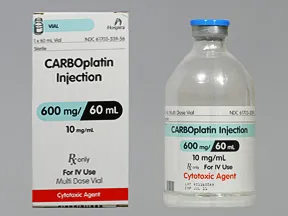 | |
| carboplatin intravenous - | 10 mg/mL vial | 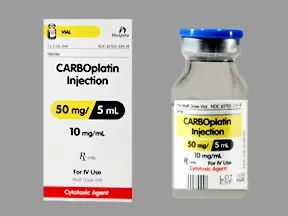 | |
| carboplatin intravenous - | 10 mg/mL vial | 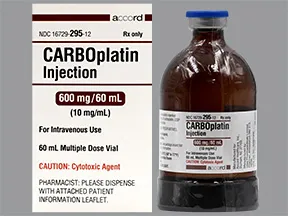 | |
| carboplatin intravenous - | 10 mg/mL vial | 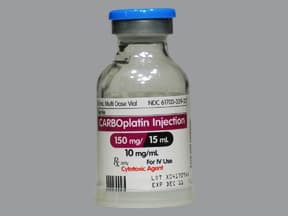 | |
| carboplatin intravenous - | 10 mg/mL vial | 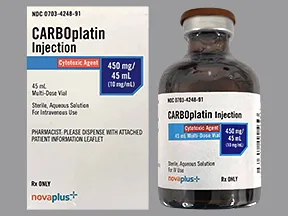 | |
| carboplatin intravenous - | 10 mg/mL vial | 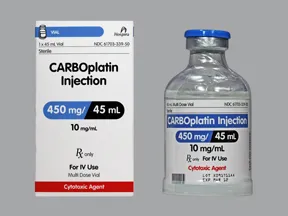 | |
| carboplatin intravenous - | 10 mg/mL vial |  | |
| carboplatin intravenous - | 10 mg/mL vial | 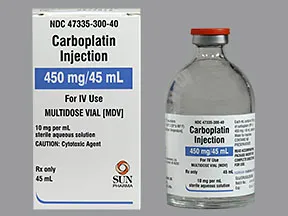 | |
| carboplatin intravenous - | 10 mg/mL vial | 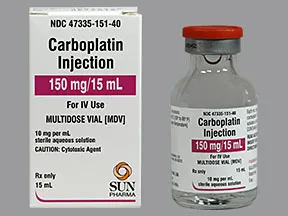 | |
| carboplatin intravenous - | 10 mg/mL vial | 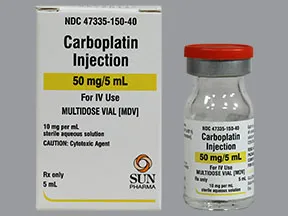 | |
| carboplatin intravenous - | 10 mg/mL vial | 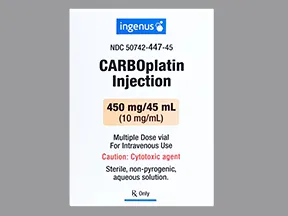 | |
| carboplatin intravenous - | 10 mg/mL vial |  | |
| carboplatin intravenous - | 10 mg/mL vial | 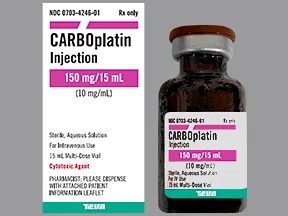 | |
| carboplatin intravenous - | 10 mg/mL vial | 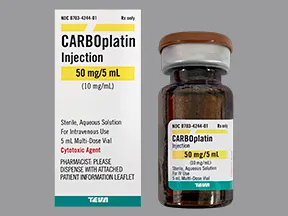 | |
| carboplatin intravenous - | 10 mg/mL vial | 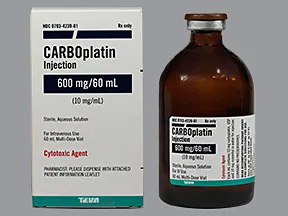 | |
| carboplatin intravenous - | 10 mg/mL vial |  | |
| carboplatin intravenous - | 10 mg/mL vial |  | |
| carboplatin intravenous - | 10 mg/mL vial | 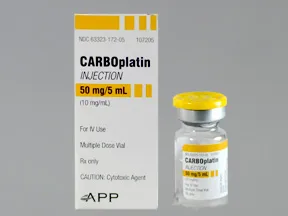 | |
| carboplatin intravenous - | 10 mg/mL vial | 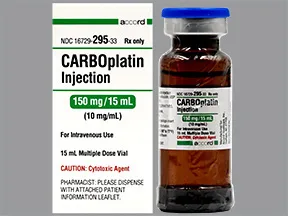 | |
| carboplatin intravenous - | 10 mg/mL vial | 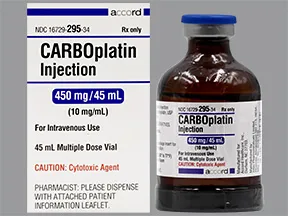 | |
| carboplatin intravenous - | 10 mg/mL vial |  | |
| carboplatin intravenous - | 10 mg/mL vial | 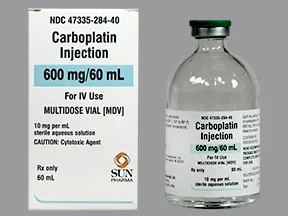 | |
| carboplatin intravenous - | 10 mg/mL vial | 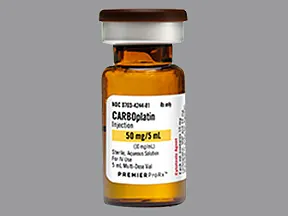 | |
| carboplatin intravenous - | 10 mg/mL vial |  |
Copyright © 2010 First DataBank, Inc.
Patient Handout
carboplatin intravenous
CARBOPLATIN - INJECTION
(CAR-bow-plah-tin)
COMMON BRAND NAME(S): Paraplatin
WARNING: Carboplatin can cause severe blood disorders (such as anemia, bone marrow suppression) that can result in infection and bleeding problems. Your risk of developing these problems increases with higher doses or longer treatment with carboplatin. Also, an unlikely but very serious allergic reaction to this drug may occur within minutes of receiving a dose. Tell your doctor right away if you develop any of the following symptoms: easy bruising/bleeding, signs of infection (such as sore throat that doesn't go away, fever), unusual tiredness, rash, itching, swelling, severe dizziness, or trouble breathing.Vomiting is a common side effect of this medication. See the Side Effects section for more information.
USES: Carboplatin is used to treat various types of cancer. It is a chemotherapy drug that contains platinum. It is used to slow or stop cancer cell growth.
HOW TO USE: Carboplatin is usually given by infusion into a vein (intravenously-IV) over at least 15 minutes by a healthcare professional.The dosage is based on your medical condition, body size, and response to treatment. In general, courses of carboplatin treatment should not be given more often than once every 4 weeks. Consult your doctor or pharmacist for more details.
SIDE EFFECTS: Stomach pain, body aches/pain, diarrhea, constipation, weakness, nausea, and vomiting may occur. Nausea and vomiting can be severe in some patients but usually go away within 24 hours of treatment. Drug therapy may be needed to prevent or relieve nausea and vomiting. Not eating before your treatment may help relieve vomiting. Changes in diet such as eating several small meals or limiting activity may help lessen some of these effects. If any of these effects last or get worse, tell your doctor or pharmacist promptly.Temporary hair loss may occur. Normal hair growth should return after treatment has ended.Remember that this medication has been prescribed because your doctor has judged that the benefit to you is greater than the risk of side effects. Many people using this medication do not have serious side effects.Tell your doctor right away if you have any serious side effects, including: numbness or tingling in the hands/feet, mouth sores, yellowing eyes/skin, dark urine, unusual tiredness, signs of kidney problems (such as change in the amount of urine), pain/swelling/redness at the injection site, hearing problems (such as ringing in the ears, hearing loss), easy bruising/bleeding, blood in the urine, black/bloody stools, fast/irregular heartbeat.Rarely, temporary vision loss may occur with high doses of carboplatin. Normal vision usually returns within several weeks after the end of treatment. Consult your doctor or pharmacist for more details and report this side effect right away if it occurs.This medication can lower your body's ability to fight an infection. Notify your doctor promptly if you develop any signs of an infection such as sore throat that doesn't go away, fever, or chills.A very serious allergic reaction to this drug is rare. However, get medical help right away if you notice any symptoms of a serious allergic reaction, including: rash, itching/swelling (especially of the face/tongue/throat), severe dizziness, trouble breathing.This is not a complete list of possible side effects. If you notice other effects not listed above, contact your doctor or pharmacist.In the US -Call your doctor for medical advice about side effects. You may report side effects to FDA at 1-800-FDA-1088 or at www.fda.gov/medwatch.In Canada - Call your doctor for medical advice about side effects. You may report side effects to Health Canada at 1-866-234-2345.
PRECAUTIONS: Before using carboplatin, tell your doctor or pharmacist if you are allergic to it, or to cisplatin; or if you have any other allergies. This product may contain inactive ingredients, which can cause allergic reactions or other problems. Talk to your pharmacist for more details.Before using this medication, tell your doctor or pharmacist your medical history, especially of: decreased bone marrow function/blood cell disorders (such as anemia, leukopenia, thrombocytopenia), kidney problems, mineral imbalance (low blood levels of sodium, potassium, magnesium, calcium).Do not have immunizations/vaccinations without the consent of your doctor, and avoid contact with people who have recently received oral polio vaccine.Use caution with sharp objects like safety razors or nail cutters and avoid activities such as contact sports to lower the chance of getting cut, bruised or injured.Wash your hands well to prevent the spread of infections.Older adults may be more sensitive to the side effects of this drug, especially to bleeding problems and numbness/tingling of the hands/feet.Children may be at greater risk for hearing loss when carboplatin is used at higher-than-recommended doses in combination with other medications that may affect hearing.This medication can affect sperm production in men. Men should use a reliable form of birth control during treatment and for some time afterwards. Consult your doctor for more details.Tell your doctor if you are pregnant or plan to become pregnant. You should not become pregnant while using carboplatin. Carboplatin may harm an unborn baby. Ask about reliable forms of birth control while using this medication and for some time after the last dose. If you become pregnant, talk to your doctor right away about the risks and benefits of this medication.It is unknown if this drug passes into breast milk. Because of the possible risk to the infant, breastfeeding is not recommended while using this drug. Consult your doctor before breastfeeding.
DRUG INTERACTIONS: Drug interactions may change how your medications work or increase your risk for serious side effects. This document does not contain all possible drug interactions. Keep a list of all the products you use (including prescription/nonprescription drugs and herbal products) and share it with your doctor and pharmacist. Do not start, stop, or change the dosage of any medicines without your doctor's approval.Some products that may interact with this drug include: aminoglycoside antibiotics (such as gentamicin, neomycin), amphotericin B, certain anti-seizure medications (hydantoins such as phenytoin), certain "water pills" (loop diuretics such as furosemide, bumetanide).
OVERDOSE: If someone has overdosed and has serious symptoms such as passing out or trouble breathing, call 911. Otherwise, call a poison control center right away. US residents can call 1-800-222-1222. Canada residents can call 1-844-764-7669.
NOTES: Lab and/or medical tests (such as complete blood counts, kidney function, blood mineral levels) should be done while you are using this medication. Keep all medical and lab appointments. Consult your doctor for more details.
MISSED DOSE: It is important to get each dose of this medication as scheduled. If you miss a dose, ask your doctor or pharmacist right away for a new dosing schedule.
STORAGE: Not applicable. This medication is given in a clinic and will not be stored at home.
MEDICAL ALERT: Your condition can cause complications in a medical emergency. For information about enrolling in MedicAlert, call 1-888-633-4298 (US) or 1-800-668-1507 (Canada).
Information last revised June 2024. Copyright(c) 2024 First Databank, Inc.
IMPORTANT: HOW TO USE THIS INFORMATION: This is a summary and does NOT have all possible information about this product. This information does not assure that this product is safe, effective, or appropriate for you. This information is not individual medical advice and does not substitute for the advice of your health care professional. Always ask your health care professional for complete information about this product and your specific health needs.
Formulary
Adding plans allows you to compare formulary status to other drugs in the same class.
To view formulary information first create a list of plans. Your list will be saved and can be edited at any time.
Adding plans allows you to:
- View the formulary and any restrictions for each plan.
- Manage and view all your plans together – even plans in different states.
- Compare formulary status to other drugs in the same class.
- Access your plan list on any device – mobile or desktop.







